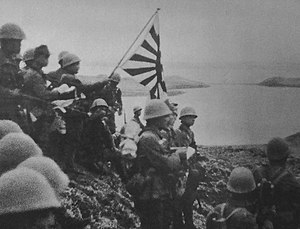
Back Japanische Besetzung von Kiska German Ocupación japonesa de Kiska Spanish تصرف کیشکا توسط ژاپن FA Pendudukan Jepang di pulau Kiska ID Occupazione giapponese di Kiska Italian 키스카섬 탈출 Korean Japanse bezetting van Kiska Dutch 日軍佔領基斯卡島 Chinese
This article includes a list of general references, but it lacks sufficient corresponding inline citations. (December 2024) |
| Japanese occupation of Kiska | |||||||||
|---|---|---|---|---|---|---|---|---|---|
| Part of the American Theater and the Pacific Theater of World War II | |||||||||
 Japanese troops raise the Imperial battle flag on Kiska after landing on 6 June 1942. | |||||||||
| |||||||||
| Belligerents | |||||||||
| Commanders and leaders | |||||||||
|
Lt. Mulls (Not present during initial landing)[1] |
| ||||||||
| Strength | |||||||||
|
10-man weather station 1-6 dogs 3 aircraft[1] |
500+ Special Naval Landing Forces (Initial force) 5,183–5,400 civilians and soldiers (Occupation)[2] | ||||||||
| Casualties and losses | |||||||||
|
2 killed 7 captured 1 escaped (later surrendered) | No casualties during initial capture, or during occupation/withdraw. | ||||||||
The Japanese occupation of Kiska took place between 6 June 1942 and 28 July 1943 during the Aleutian Islands campaign of the American Theater and the Pacific Theater of World War II. The Japanese occupied Kiska and nearby Attu Island in order to protect the northern flank of the Japanese Empire.
- ^ a b "Caption for (WX16-Sept.22) Navy's Kiska Weather Unit Held Prisoners By Japs". Archived from the original on 2015-08-25. Retrieved 2015-04-28.
- ^ PacificWrecks.com. "Pacific Wrecks". Retrieved 25 July 2018.